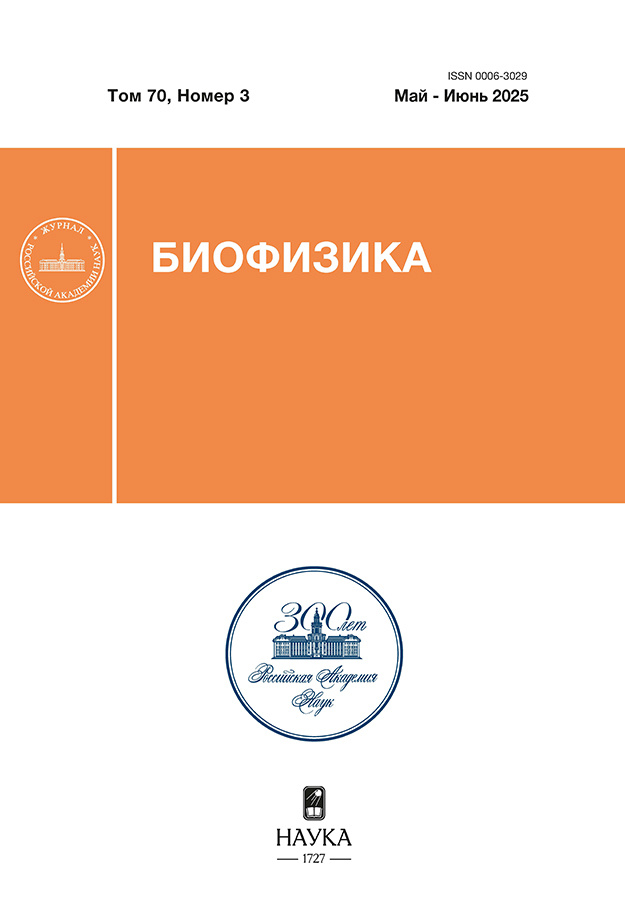The Role of Metabolites of the Phosphoinositide Cycle in the Regulation of Excitation Conditions and Regeneration of Damaged Somatic Nerves under the Action of Insulin-Like Growth Factor-1
- 作者: Chudalkina E.V1, Parchaykina M.V1, Molchanov I.D1, Revina E.S1, Zavarykina A.V1, Simakova M.A1, Grunyushkin I.P1, Revin V.V1
-
隶属关系:
- National Research Ogarev Mordovia State University
- 期: 卷 70, 编号 3 (2025)
- 页面: 512-526
- 栏目: Cell biophysics
- URL: https://rjraap.com/0006-3029/article/view/687541
- DOI: https://doi.org/10.31857/S0006302925030096
- EDN: https://elibrary.ru/KTDCVD
- ID: 687541
如何引用文章
详细
作者简介
E. Chudalkina
National Research Ogarev Mordovia State University
Email: mary.isakina@yandex.ru
Saransk, Russia
M. Parchaykina
National Research Ogarev Mordovia State UniversitySaransk, Russia
I. Molchanov
National Research Ogarev Mordovia State UniversitySaransk, Russia
E. Revina
National Research Ogarev Mordovia State UniversitySaransk, Russia
A. Zavarykina
National Research Ogarev Mordovia State UniversitySaransk, Russia
M. Simakova
National Research Ogarev Mordovia State UniversitySaransk, Russia
I. Grunyushkin
National Research Ogarev Mordovia State UniversitySaransk, Russia
V. Revin
National Research Ogarev Mordovia State UniversitySaransk, Russia
参考
- Adidharma W., Khouri A. N., Lee J. C., Vanderboll K., Kung T. A., Cederna P. S., and Kemp S.W. P. Sensory nerve regeneration and reinnervation in muscle following peripheral nerve injury. , , 384–396 (2022). doi: 10.1002/mus.27661
- Slavin B. R., Sarhan K. A., von Guionneau N., Hanwright P. J., Qiu C., Mao H. Q., Höke A., and Tuffaha S. H. Insulin-like growth factor-1: A promising therapeutic target for peripheral nerve injury. , , 695850 (2021). doi: 10.3389/fbioc.2021.695850
- Revin V. V., Nabokina S. M., Anisimova I. A., and Gruniushkin I. P. Activity of phosphoinositide-specific phospholipase C in rabbit nerves at rest and during stimulation. , (5), 815–820 (1996).
- Parchaykina M., Chudalkina E., Revina E., Molchanov I., Zavarykina A., Popkov E., and Revin V. The effect of insulin-like growth factor-1 on the quantitative and qualitative composition of phosphoinositide cycle components during the damage and regeneration of somatic nerves. , (4), 60 (2024). doi: 10.3390/scipharm92040060
- Roy D. and Tedeschi A. The role of lipids, lipid metabolism and ectopic lipid accumulation in axon growth, regeneration and repair after CNS injury and disease. , (5), 1078 (2021). doi: 10.3390/cells10051078
- Bligh E. G. and Dyer W. J. A rapid method of total lipid extraction and purification. , (8), 911–917 (1959). doi: 10.1139/o59-099
- Прохорова М. И., Романова Л. С. и Туманова С. Ю. (Наука, М., 1967).
- Findlay J. B. C. and Howard Evans W. (IRL Press, 1987).
- Morrison W. R. and Smith L. M. Preparation of fatty acid methyl esters and dimethylacetals from lipids with boron fluoride-methanol. , , 600–608 (1964).
- Kuz’menko T. P., Parchaykina M. V., Revina E. S., Gladysheva M. Y., and Revin V. V. Influence of neurotrophic factors on the composition of proteins during damage and regeneration of somatic nerves. , , 334–348 (2023). doi: 10.31857/S0006302923020138
- Cocco L., Follo M. Y., Manzoli L., and Suh P. G. Phosphoinositide-specific phospholipase C in health and disease. , (10), 1853–1860 (2015). doi: 10.1194/jir.R057984
- Nelson T. J., Sun M. K., Hongpaisan J., and Alkon D. L. Insulin, PKC signaling pathways and synaptic remodeling during memory storage and neuronal repair. , (1), 76–87 (2008). doi: 10.1016/j.ejphar.2008.01.051
- Ревина Э. С., Девяткин А. А., Ревин В. В. и Громова Н. В. (Изд-во Мордов. ун-та, Саранск, 2012).
- Nuñez A., Zegarra-Valdivia J., Fernandez de Sevilla D., Pignatelli J., and Torres Aleman I. The neurobiology of insulin-like growth factor I: From neuroprotection to modulation of brain states. , (8), 3220–3230 (2023). doi: 10.1038/s41380-023-02136-6
- Britten-Jones A. C., Craig J. P., Anderson A. J., and Downie L. E. Association between systemic omega-3 polyunsaturated fatty acid levels and corneal nerve structure and function. . , 1866–1873 (2023). doi: 10.1038/s41433-022-02259-0
- Iqbal Z., Bashir B., Ferdousi M., Kalteniece A., Alam U., Malik R. A., and Soran H. Lipids and peripheral neuropathy. , (4), 249–257 (2021). doi: 10.1097/MOL.0000000000000770
- de Almeida Melo Maciel Mangueira M., Caparelli-Dáquer E., Filho O. P. G., de Assis D. S. F. R., Sousa J. K. C., Lima W. L., Pinheiro A. L. B., Silveira L. Jr., and Mangueira N. M. Raman spectroscopy and sciatic functional index (SFI) after low-level laser therapy (LLLT) in a rat sciatic nerve crush injury model. , (7), 2957–2971 (2022). doi: 10.1007/s10103-022-03565-5
- Guo Y., Sun L., Zhong W., Zhang N., Zhao Z., and Tian W. Artificial intelligence-assisted repair of peripheral nerve injury: a new research hotspot and associated challenges. , (3), 663–670 (2024). doi: 10.4103/1673-5374.380909
- Morisaki S., Ota C., Matsuda K., Kaku N., Fujiwara H., Oda R., Ishibashi H., Kubo T., and Kawata M. Application of Raman spectroscopy for visualizing biochemical changes during peripheral nerve injury in vitro and in vivo. , (11), 116011 (2013). doi: 10.1117/1.JBO.18.11.116011
- Li R., Slipchenko M. N., Wang P., and Cheng J. X. Compact high power barium nitrite crystal-based Raman laser at 1197 nm for photoacoustic imaging of fat. , (4), 040502 (2013). doi: 10.1117/1.JBO.18.4.040502
- Forbes B. E., Blyth A. J., and Wit J. M. Disorders of IGFs and IGF-1R signaling pathways. , , 11035 (2020). doi: 10.1016/j.mce.2020.11035
- Dya G. A., Klychnikov O. I., Adasheva D. A., Vladychenskaya E. A., Katrukha A. G., and Serebryanaya D. V. IGF-Binding proteins and their proteolysis as a mechanism of regulated IGF release in the nervous tissue. , (S1), 105–122 (2023). doi: 10.1134/S0006297923140079
- Nieuwenhuis B. and Eva R. Promoting axon regeneration in the central nervous system by increasing PI3-kinase signaling. , (6), 1172–1182 (2022). doi: 10.4103/1673-5374.327324
- Wissessowapak C., Niyomchan A., Visimonthachai D., Leelaprachakul N., Watcharasit P., and Satayavivad J. Arsenic-induced IGF-1 signaling impairment and neurite shortening: The protective roles of IGF-1 through the PI3K/Akt axis. , (3), 1119–1128 (2024). doi: 10.1002/tox.23995
补充文件









